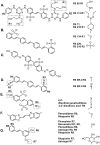Calcofluor white combination antifungal treatments for Trichophyton rubrum and Candida albicans
- PMID: 22792174
- PMCID: PMC3391284
- DOI: 10.1371/journal.pone.0039405
Calcofluor white combination antifungal treatments for Trichophyton rubrum and Candida albicans
Abstract
Superficial mycoses caused by dermatophyte fungi are among the most common infections worldwide, yet treatment is restricted by limited effective drugs available, drug toxicity, and emergence of drug resistance. The stilbene fluorescent brightener calcofluor white (CFW) inhibits fungi by binding chitin in the cell wall, disrupting cell wall integrity, and thus entails a different mechanism of inhibition than currently available antifungal drugs. To identify novel therapeutic options for the treatment of skin infections, we compared the sensitivity of representative strains of the dermatophyte Trichophyton rubrum and Candida albicans to CFW and a panel of fluorescent brighteners and phytoalexin compounds. We identified the structurally related stilbene fluorescent brighteners 71, 85, 113 and 134 as fungicidal to both T. rubrum and C. albicans to a similar degree as CFW, and the stilbene phytoalexins pinosylvan monomethyl ether and pterostilbene inhibited to a lesser degree, allowing us to develop a structure-activity relationship for fungal inhibition. Given the abilities of CFW to absorb UV(365 nm) and bind specifically to fungal cell walls, we tested whether CFW combined with UV(365 nm) irradiation would be synergistic to fungi and provide a novel photodynamic treatment option. However, while both treatments individually were cytocidal, UV(365 nm) irradiation reduced sensitivity to CFW, which we attribute to CFW photoinactivation. We also tested combination treatments of CFW with other fungal inhibitors and identified synergistic interactions between CFW and some ergosterol biosynthesis inhibitors in C. albicans. Therefore, our studies identify novel fungal inhibitors and drug interactions, offering promise for combination topical treatment regimes for superficial mycoses.
Conflict of interest statement
Figures


Similar articles
-
In vitro combination therapy using low dose clotrimazole and photodynamic therapy leads to enhanced killing of the dermatophyte Trichophyton rubrum.BMC Microbiol. 2014 Oct 15;14:261. doi: 10.1186/s12866-014-0261-z. BMC Microbiol. 2014. PMID: 25316407 Free PMC article.
-
Calcofluor White-Phosphatidylethanolamine Conjugate-Enhanced Ethosomal Delivery of Voriconazole for Targeting Candida albicans.Int J Nanomedicine. 2024 Dec 5;19:13047-13069. doi: 10.2147/IJN.S488456. eCollection 2024. Int J Nanomedicine. 2024. PMID: 39654804 Free PMC article.
-
Acidophilic actinobacteria synthesised silver nanoparticles showed remarkable activity against fungi-causing superficial mycoses in humans.Mycoses. 2016 Mar;59(3):157-66. doi: 10.1111/myc.12445. Epub 2015 Dec 16. Mycoses. 2016. PMID: 26671603
-
Sertaconazole: a review of its use in the management of superficial mycoses in dermatology and gynaecology.Drugs. 2009;69(3):339-59. doi: 10.2165/00003495-200969030-00009. Drugs. 2009. PMID: 19275277 Review.
-
Antifungal resistance in superficial mycoses.J Dermatolog Treat. 2022 Jun;33(4):1888-1895. doi: 10.1080/09546634.2021.1942421. Epub 2021 Jun 30. J Dermatolog Treat. 2022. PMID: 34132155 Review.
Cited by
-
Chitin synthase A: a novel epidermal development regulation gene in the larvae of Bombyx mori.Mol Biol Rep. 2014 Jul;41(7):4177-86. doi: 10.1007/s11033-014-3288-1. Epub 2014 Feb 28. Mol Biol Rep. 2014. PMID: 24577751
-
Enhancement of insect susceptibility and larvicidal efficacy of Cry4Ba toxin by calcofluor.Parasit Vectors. 2018 Sep 20;11(1):515. doi: 10.1186/s13071-018-3110-3. Parasit Vectors. 2018. PMID: 30236155 Free PMC article.
-
Direct Visualization of Fungal Burden in Filamentous Fungus-Infected Silkworms.J Fungi (Basel). 2021 Feb 13;7(2):136. doi: 10.3390/jof7020136. J Fungi (Basel). 2021. PMID: 33668495 Free PMC article.
-
Non-thermal plasma causes Pseudomonas aeruginosa biofilm release to planktonic form and inhibits production of Las-B elastase, protease and pyocyanin.Front Cell Infect Microbiol. 2022 Sep 23;12:993029. doi: 10.3389/fcimb.2022.993029. eCollection 2022. Front Cell Infect Microbiol. 2022. PMID: 36211963 Free PMC article.
-
Responses of Sporothrix globosa to the cell wall perturbing agents Congo Red and Calcofluor White.Antonie Van Leeuwenhoek. 2021 May;114(5):609-624. doi: 10.1007/s10482-021-01545-3. Epub 2021 Mar 3. Antonie Van Leeuwenhoek. 2021. PMID: 33660079
References
-
- Aly R. Ecology and epidemiology of dermatophyte infections. J Am Acad Dermatol. 1994;31:S21–25. - PubMed
-
- Djeridane A, Djeridane Y, Ammar-Khodja A. Epidemiological and aetiological study on tinea pedis and onychomycosis in Algeria. Mycoses. 2006;49:190–196. - PubMed
-
- Welsh O, Vera-Cabrera L, Welsh E. Onychomycosis. Clin Dermatol. 2010;28:151–159. - PubMed
-
- Haneke E, Roseeuw D. The scope of onychomycosis: epidemiology and clinical features. Int J Dermatol. 1999;38:7–12. - PubMed
-
- Gupta AK, Scher RK. Oral antifungal agents for onychomycosis. Lancet. 1998;351:541–542. - PubMed
Publication types
MeSH terms
Substances
Grants and funding
LinkOut - more resources
Full Text Sources
Other Literature Sources

